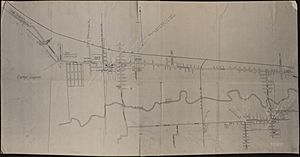Houston riot of 1917 facts for kids
Quick facts for kids Houston riot of 1917 |
|||
|---|---|---|---|

Court Martial of 64 members of the 24th Infantry. Trial started November 1, 1917, Fort Sam Houston
|
|||
| Date | 23 August 1917 | ||
| Location | |||
| Parties to the civil conflict | |||
|
|||
| Lead figures | |||
|
|||
| Arrests, etc. | |||
|
|||
| 19 soldiers executed after court-martials and other proceedings | |||
The Houston Riot of 1917 was a mutiny and riot by 156 soldiers from the all-black 24th Infantry Regiment of the United States Army, taking place on August 23, 1917, in Houston, Texas.
Contents
The riot
The incident occurred within a climate of overt hostility from members of the all-white Houston Police Department (HPD) against members of the local black community and black soldiers stationed at Camp Logan. Following an incident where police officers arrested and assaulted some black soldiers, many of their comrades mutinied and marched to Houston, where they opened fire and killed eleven civilians and five policemen. Four soldiers were also killed and Sergeant Vida Henry, who led the mutineers, died. In accordance with policies of the time, the soldiers were tried at three courts-martial; nineteen were executed, and 41 were sentenced to life imprisonment.
Immediate aftermath
The next morning, Houston was placed under martial law. The remaining soldiers at Camp Logan were disarmed, and a house-to-house search uncovered a number of soldiers hiding within the San Felipe district. Soldiers in local jails were turned over to the Army, and the 3rd Battalion was sent by train back to New Mexico.
In the ensuing court-martial, almost two hundred witnesses testified over twenty-two days, and the transcripts of the testimony covered more than two thousand pages.
Although 169 witnesses testified at the court-martial, the darkness and rain meant that many of the witnesses were unable to correctly identify any of the alleged assailants. Historians have also questioned the veracity of witness testimony, noting that the some of the witnesses who testified as participants were granted immunity or promised leniency.
The first execution
The condemned soldiers (one sergeant, four corporals, and eight privates) were transferred to a barracks on December 10 and executed simultaneously at 7:17am.
Second and third courts martial
A second court-martial, the "Washington" case, began six days later. Fifteen men of the Lower A Division were tried and five were sentenced to death. On January 2, 1918, Ruckman approved the sentences in a public statement. But a new rule, General Orders 167 (December 29, 1917), prohibited the execution of any death sentence until the JAG could review the sentences (the JAG Boards of Review tasked with reviewing death sentences were created by a subsequent rule, General Orders 7, on January 7, 1918). Those boards, though they had advisory power only, were the Army's first appellate courts.)
While waiting for the JAG review to occur, Ruckman approved a third court-martial, the "Tillman" case, of forty more soldiers. On March 26, 1918, twenty-three of those forty soldiers were found guilty. Eleven of the twenty-three were sentenced to death and the remaining twelve to life in prison. On May 2, Ruckman approved the sentences.
Release and rehabilitation
On 14 December 1924, four of the rioters were released on parole, with 34 remaining imprisoned in Fort Leavenworth.
On 8 March 1927, President Calvin Coolidge reduced the sentences for the last 20 imprisoned rioters, making them eligible for parole within one year.
In 1937 the remains of the 13 executed soldiers were exhumed from their unmarked graves and reburied with military headstones in Fort Sam Houston National Cemetery.
As at February 2022 the Pentagon is reviewing a clemency petition for all those convicted in the riot.
Camp Logan today
The area where Camp Logan was located is now called Memorial Park. It is bordered by highways I-10 and I-610.




